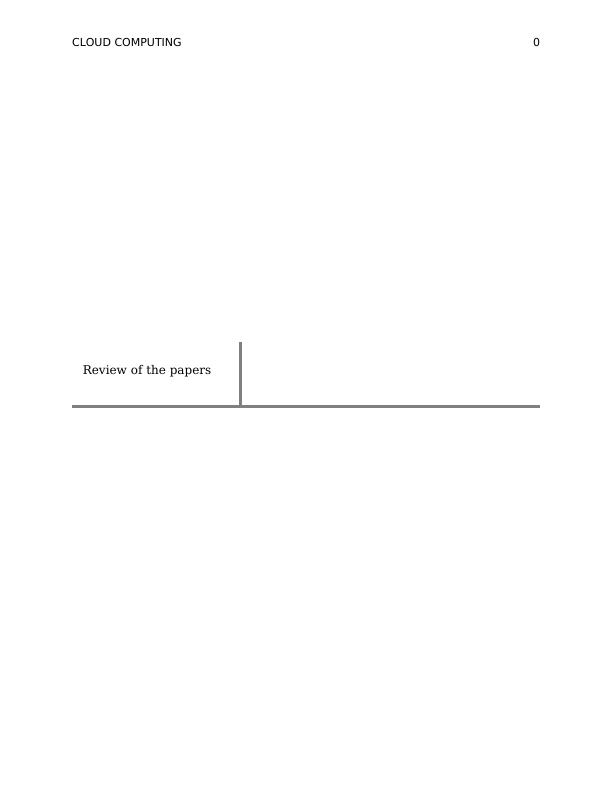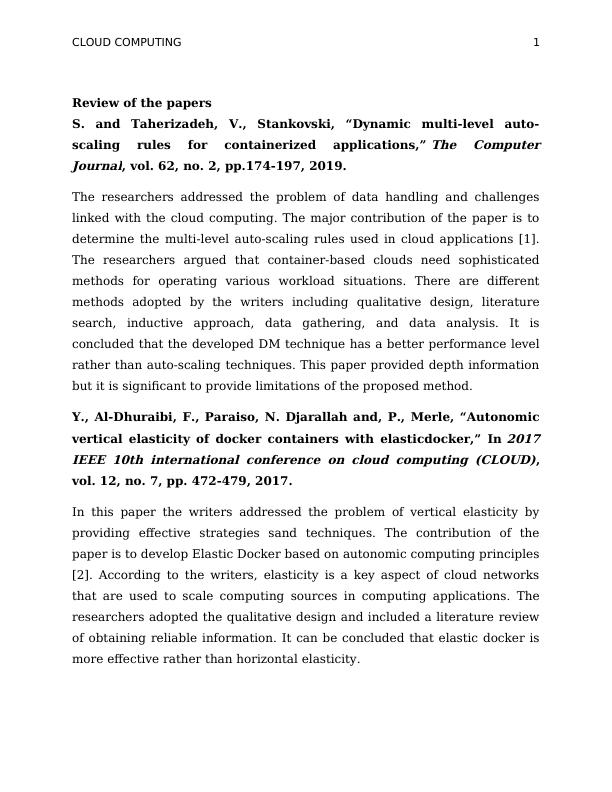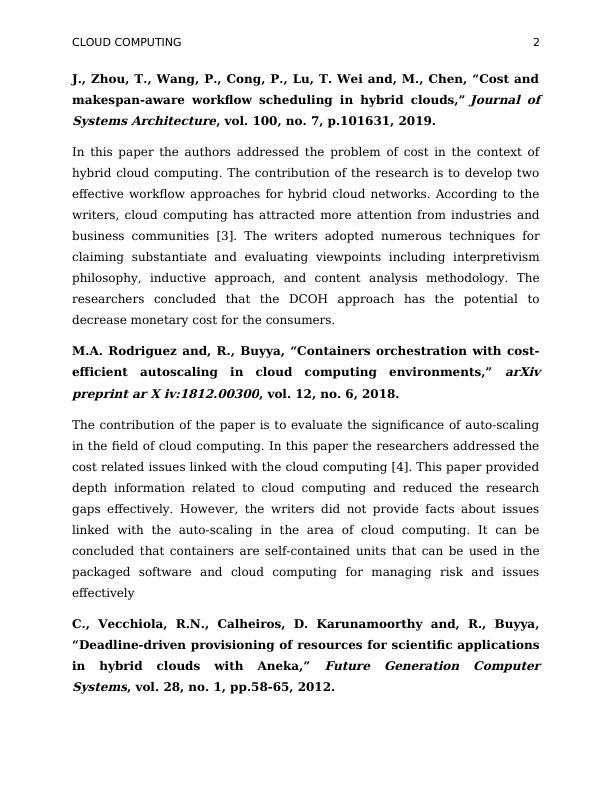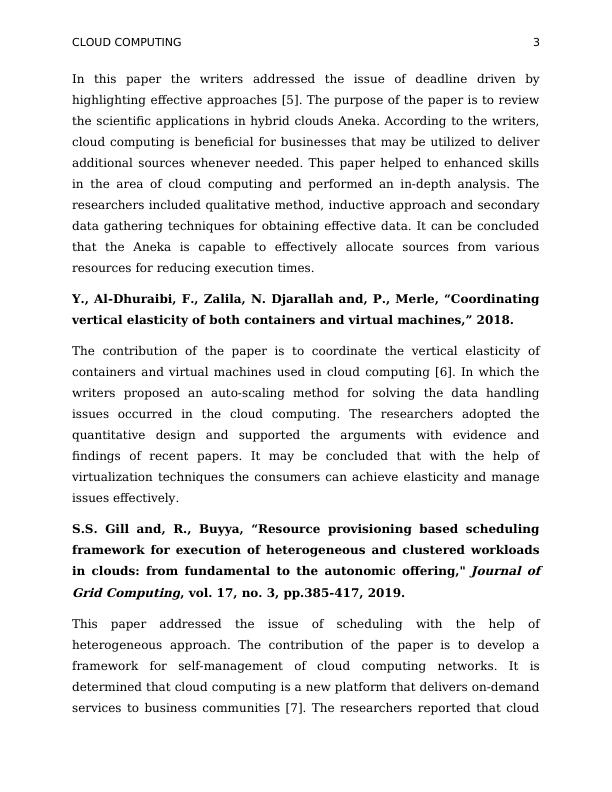Dynamic Multi-Level Auto-Scaling Rules
Added on 2022-08-14
13 Pages3470 Words18 Views
CLOUD COMPUTING 0
Review of the papers
Review of the papers

CLOUD COMPUTING 1
Review of the papers
S. and Taherizadeh, V., Stankovski, “Dynamic multi-level auto-
scaling rules for containerized applications,”
The Computer
Journal, vol. 62, no. 2, pp.174-197, 2019.
The researchers addressed the problem of data handling and challenges
linked with the cloud computing. The major contribution of the paper is to
determine the multi-level auto-scaling rules used in cloud applications [1].
The researchers argued that container-based clouds need sophisticated
methods for operating various workload situations. There are different
methods adopted by the writers including qualitative design, literature
search, inductive approach, data gathering, and data analysis. It is
concluded that the developed DM technique has a better performance level
rather than auto-scaling techniques. This paper provided depth information
but it is significant to provide limitations of the proposed method.
Y., Al-Dhuraibi, F., Paraiso, N. Djarallah and, P., Merle, “Autonomic
vertical elasticity of docker containers with elasticdocker,” In
2017
IEEE 10th international conference on cloud computing (CLOUD),
vol. 12, no. 7, pp. 472-479, 2017.
In this paper the writers addressed the problem of vertical elasticity by
providing effective strategies sand techniques. The contribution of the
paper is to develop Elastic Docker based on autonomic computing principles
[2]. According to the writers, elasticity is a key aspect of cloud networks
that are used to scale computing sources in computing applications. The
researchers adopted the qualitative design and included a literature review
of obtaining reliable information. It can be concluded that elastic docker is
more effective rather than horizontal elasticity.
Review of the papers
S. and Taherizadeh, V., Stankovski, “Dynamic multi-level auto-
scaling rules for containerized applications,”
The Computer
Journal, vol. 62, no. 2, pp.174-197, 2019.
The researchers addressed the problem of data handling and challenges
linked with the cloud computing. The major contribution of the paper is to
determine the multi-level auto-scaling rules used in cloud applications [1].
The researchers argued that container-based clouds need sophisticated
methods for operating various workload situations. There are different
methods adopted by the writers including qualitative design, literature
search, inductive approach, data gathering, and data analysis. It is
concluded that the developed DM technique has a better performance level
rather than auto-scaling techniques. This paper provided depth information
but it is significant to provide limitations of the proposed method.
Y., Al-Dhuraibi, F., Paraiso, N. Djarallah and, P., Merle, “Autonomic
vertical elasticity of docker containers with elasticdocker,” In
2017
IEEE 10th international conference on cloud computing (CLOUD),
vol. 12, no. 7, pp. 472-479, 2017.
In this paper the writers addressed the problem of vertical elasticity by
providing effective strategies sand techniques. The contribution of the
paper is to develop Elastic Docker based on autonomic computing principles
[2]. According to the writers, elasticity is a key aspect of cloud networks
that are used to scale computing sources in computing applications. The
researchers adopted the qualitative design and included a literature review
of obtaining reliable information. It can be concluded that elastic docker is
more effective rather than horizontal elasticity.

CLOUD COMPUTING 2
J., Zhou, T., Wang, P., Cong, P., Lu, T. Wei and, M., Chen, “Cost and
makespan-aware workflow scheduling in hybrid clouds,”
Journal of
Systems Architecture, vol. 100, no. 7, p.101631, 2019.
In this paper the authors addressed the problem of cost in the context of
hybrid cloud computing. The contribution of the research is to develop two
effective workflow approaches for hybrid cloud networks. According to the
writers, cloud computing has attracted more attention from industries and
business communities [3]. The writers adopted numerous techniques for
claiming substantiate and evaluating viewpoints including interpretivism
philosophy, inductive approach, and content analysis methodology. The
researchers concluded that the DCOH approach has the potential to
decrease monetary cost for the consumers.
M.A. Rodriguez and, R., Buyya, “Containers orchestration with cost-
efficient autoscaling in cloud computing environments,”
arXiv
preprint ar X iv:1812.00300, vol. 12, no. 6, 2018.
The contribution of the paper is to evaluate the significance of auto-scaling
in the field of cloud computing. In this paper the researchers addressed the
cost related issues linked with the cloud computing [4]. This paper provided
depth information related to cloud computing and reduced the research
gaps effectively. However, the writers did not provide facts about issues
linked with the auto-scaling in the area of cloud computing. It can be
concluded that containers are self-contained units that can be used in the
packaged software and cloud computing for managing risk and issues
effectively
C., Vecchiola, R.N., Calheiros, D. Karunamoorthy and, R., Buyya,
“Deadline-driven provisioning of resources for scientific applications
in hybrid clouds with Aneka,”
Future Generation Computer
Systems, vol. 28, no. 1, pp.58-65, 2012.
J., Zhou, T., Wang, P., Cong, P., Lu, T. Wei and, M., Chen, “Cost and
makespan-aware workflow scheduling in hybrid clouds,”
Journal of
Systems Architecture, vol. 100, no. 7, p.101631, 2019.
In this paper the authors addressed the problem of cost in the context of
hybrid cloud computing. The contribution of the research is to develop two
effective workflow approaches for hybrid cloud networks. According to the
writers, cloud computing has attracted more attention from industries and
business communities [3]. The writers adopted numerous techniques for
claiming substantiate and evaluating viewpoints including interpretivism
philosophy, inductive approach, and content analysis methodology. The
researchers concluded that the DCOH approach has the potential to
decrease monetary cost for the consumers.
M.A. Rodriguez and, R., Buyya, “Containers orchestration with cost-
efficient autoscaling in cloud computing environments,”
arXiv
preprint ar X iv:1812.00300, vol. 12, no. 6, 2018.
The contribution of the paper is to evaluate the significance of auto-scaling
in the field of cloud computing. In this paper the researchers addressed the
cost related issues linked with the cloud computing [4]. This paper provided
depth information related to cloud computing and reduced the research
gaps effectively. However, the writers did not provide facts about issues
linked with the auto-scaling in the area of cloud computing. It can be
concluded that containers are self-contained units that can be used in the
packaged software and cloud computing for managing risk and issues
effectively
C., Vecchiola, R.N., Calheiros, D. Karunamoorthy and, R., Buyya,
“Deadline-driven provisioning of resources for scientific applications
in hybrid clouds with Aneka,”
Future Generation Computer
Systems, vol. 28, no. 1, pp.58-65, 2012.

CLOUD COMPUTING 3
In this paper the writers addressed the issue of deadline driven by
highlighting effective approaches [5]. The purpose of the paper is to review
the scientific applications in hybrid clouds Aneka. According to the writers,
cloud computing is beneficial for businesses that may be utilized to deliver
additional sources whenever needed. This paper helped to enhanced skills
in the area of cloud computing and performed an in-depth analysis. The
researchers included qualitative method, inductive approach and secondary
data gathering techniques for obtaining effective data. It can be concluded
that the Aneka is capable to effectively allocate sources from various
resources for reducing execution times.
Y., Al-Dhuraibi, F., Zalila, N. Djarallah and, P., Merle, “Coordinating
vertical elasticity of both containers and virtual machines,” 2018.
The contribution of the paper is to coordinate the vertical elasticity of
containers and virtual machines used in cloud computing [6]. In which the
writers proposed an auto-scaling method for solving the data handling
issues occurred in the cloud computing. The researchers adopted the
quantitative design and supported the arguments with evidence and
findings of recent papers. It may be concluded that with the help of
virtualization techniques the consumers can achieve elasticity and manage
issues effectively.
S.S. Gill and, R., Buyya, “Resource provisioning based scheduling
framework for execution of heterogeneous and clustered workloads
in clouds: from fundamental to the autonomic offering,"
Journal of
Grid Computing, vol. 17, no. 3, pp.385-417, 2019.
This paper addressed the issue of scheduling with the help of
heterogeneous approach. The contribution of the paper is to develop a
framework for self-management of cloud computing networks. It is
determined that cloud computing is a new platform that delivers on-demand
services to business communities [7]. The researchers reported that cloud
In this paper the writers addressed the issue of deadline driven by
highlighting effective approaches [5]. The purpose of the paper is to review
the scientific applications in hybrid clouds Aneka. According to the writers,
cloud computing is beneficial for businesses that may be utilized to deliver
additional sources whenever needed. This paper helped to enhanced skills
in the area of cloud computing and performed an in-depth analysis. The
researchers included qualitative method, inductive approach and secondary
data gathering techniques for obtaining effective data. It can be concluded
that the Aneka is capable to effectively allocate sources from various
resources for reducing execution times.
Y., Al-Dhuraibi, F., Zalila, N. Djarallah and, P., Merle, “Coordinating
vertical elasticity of both containers and virtual machines,” 2018.
The contribution of the paper is to coordinate the vertical elasticity of
containers and virtual machines used in cloud computing [6]. In which the
writers proposed an auto-scaling method for solving the data handling
issues occurred in the cloud computing. The researchers adopted the
quantitative design and supported the arguments with evidence and
findings of recent papers. It may be concluded that with the help of
virtualization techniques the consumers can achieve elasticity and manage
issues effectively.
S.S. Gill and, R., Buyya, “Resource provisioning based scheduling
framework for execution of heterogeneous and clustered workloads
in clouds: from fundamental to the autonomic offering,"
Journal of
Grid Computing, vol. 17, no. 3, pp.385-417, 2019.
This paper addressed the issue of scheduling with the help of
heterogeneous approach. The contribution of the paper is to develop a
framework for self-management of cloud computing networks. It is
determined that cloud computing is a new platform that delivers on-demand
services to business communities [7]. The researchers reported that cloud

End of preview
Want to access all the pages? Upload your documents or become a member.
Related Documents
Novel Heuristic Search Method for Two-level Approximate Logic Synthesislg...
|7
|474
|18
THE CLOUD COMPUTINGlg...
|15
|3490
|21